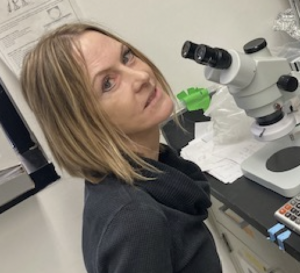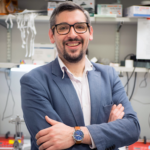Ph.D. Thesis Mentors
- Primary Faculty
- Ph.D. Thesis Mentors
- M.S. Research Mentors
GERARD AHERN: ION CHANNELS AND SENSORY RECEPTORS

Professor, Pharmacology and Physiology
Ahern Lab
gpa3@georgetown.edu
Office: Med-Dent SW401
Lab: Med-Dent SW402
Education: BSc (Hons), 1990, LL. B., 1991, University of Canterbury (New Zealand); PhD, 1996, Australian National University (Australia)
Current Research: How do cells detect changes in the external or extracellular environment? We are interested in the fundamental mechanisms that allow cells to sense diverse chemical or physical stimuli. Our focus is a class of membrane ion channels called “Transient Receptor Potential” (TRP) channels. We also explore novel ligand signaling at G-protein coupled receptors both in neurons and immune cells. We use a combination of electrophysiological, cell imaging, genetic and biochemical techniques, and where possible, appropriate animal models.
Available for research rotations during 2024-2025, likely to accept new thesis students in 2025.
TINATIN I. BRELIDZE: STRUCTURE AND FUNCTION OF ION CHANNELS

Associate Professor, Pharmacology and Physiology
Brelidze Lab
tib5@georgetown.edu
(202) 687-6178
Office: Med-Dent SE406
Lab: Med-Dent SE406
Education: Diploma in Physics (Hons), Tbilisi State University (Georgia), 1996; Ph.D. Physiology & Biophysics, University of Miami, 2003
Current Research: Ion channels are integral membrane proteins that regulate the passage of ions through cell membranes. Ion channels are essential for physiological function of living cells and abnormalities in ion channel function or expression pattern are often linked to inherited or acquired diseases. The research in my laboratory is focused on studies of mechanisms responsible for opening and closing of ion channels, identification of novel ion channel regulators and investigation of therapeutic potential of ion channel regulators. In our studies we use a variety of methods, including electrophysiology, biochemistry techniques, fluorescence-based methods, and zebrafish and rodent animal models.
KATHERINE CONANT: PROTEOLYTIC MODULATION OF NEURONAL STRUCTURE AND FUNCTION

Professor
MD, Boston University School of Medicine
AB, Cornell University
Phone: 202.687.8614
Fax: 202.687.0617
E-mail: kec84@georgetown.edu
Matrix metalloproteinases (MMPs) are a family of zinc-dependent endopeptidases that can be released and/or activated in a neuronal activity dependent manner. MMP expression and activity can also be dramatically upregulated with injury, including that mediated by infection or hypoxia. Many studies have therefore focused on their role in brain pathology. Physiological release of MMPs is, however, critical adaptive processes including learning and memory.
Our work is focused on the mechanisms by which MMPs influence neuronal and synaptic structure and function. We are particularly interested in their ability to cleave specific synaptic adhesion molecules and their ability to influence population activity through modulation of the perineuronal net. MMP mediated effects on neuronal structure and function are tested in varied models, including those related to disease. Present PhD students include Griffin Greco, Ismary Blanco, Katie Hummel, Matthew Amontree and Karli Gilbert. Former PhD students include Doctors Megan Allen, Lorenzo Bozzelli, and Seham Alaiyed.
HONG-YUAN CHU

Associate Professor, Pharmacology and Physiology
hc948@georgetown.edu
Lab Website
Office: Med-Dent NW410
Education: Ph.D., Neuropharmacology, Shanghai Institute of Materia Medica, Chinese Academy of Sciences, 2010
Current Responsibilities: Parkinson’s disease is characterized by the progressive degeneration of midbrain cells that produce and release dopamine and the accumulation of insoluble protein aggregates. Loss of dopamine-producing cells dramatically affect how the brain controls behaviors, leading to the manifestation of the feature parkinsonian motor symptoms, including the slowness, or even the absence, of motor activities. The accumulation and propagation of insoluble protein aggregates has been closely associated with the pathogenesis and progression of the disease. Our lab research focuses on understanding how the loss of dopamine and/or presence of protein aggregates may impact normal function of the brain circuits, which in turn leads to numerous aspects of motor and nonmotor defects in parkinsonism.
The lab is accepting students for rotations and thesis work.
RHONDA DZAKPASU: SPATIO-TEMPORAL PATTERNING IN IN VITRO NEURAL SYSTEMS

Associate Professor, Physics and Pharmacology
Neural Dynamics Lab
dzakpasu@physics.georgetown.edu
(202) 687-4918
Office: Med-Dent C405
Lab: Med-Dent C405
Education: University of Michigan, Ph.D., 2003
Current Research: We use arrays of extracellular multi-electrodes to record and stimulate electrical activity from cultured neural circuits as well as from acute neural slices. We modulate network rhythmicity by manipulating the balance between excitation and inhibition to investigate the principles by which neurons interact. What is the causal role of emergent coherent activity for neuronal communication?
REBEKAH EVANS: NEURAL DYNAMICS AND FUNCTIONAL CONNECTIVITY

Assistant Professor, Department of Neuroscience
NeurosciencePhD in Neuroscience, George Mason University
New Research Building EG31
Email: re285@georgetown.edu
Lab Site: https://sites.google.com/view/evans-lab/home (new window)
The Evans Lab studies neural dynamics and functional connectivity in brain structures that degenerate in Parkinson’s Disease. Dr. Evans’ lab uses systems, cellular, and computational neuroscience approaches to test how circuit alterations within the brain can protect vulnerable neurons from neurodegeneration.
To probe circuitry, the Evans lab uses two-photon calcium imaging with simultaneous optogenetics to image neural activity under highly specific stimulation conditions in active brain slices. To further dissect these circuits, in vivo optogenetics and calcium imaging approaches are employed to control and record neural activity during animal behavior. At the cellular level, the Evans lab images dendrites and dendritic spines during synaptic activity to understand how specific inputs modulate information processing within a single cell.
Research Questions:
How does nicotine re-arrange brain circuitry to protect against Parkinson’s Disease?
How do dendrites process information from multiple long range inputs?
Possibly available for research rotations during 2024-2025, likely not accept new thesis students in 2025
PATRICK A. FORCELLI: NEUROPHARMACOLOGY AND NEURAL CIRCUITS OF EPILEPSY

Director, PhD in Pharmacology & Physiology;
Professor, Pharmacology & Physiology
Website
paf22@georgetown.edu
202-687-7825
Office: NRB W214
Education: Ph.D. (Neuroscience), Georgetown University, 2011
Current Research: Research in the laboratory focuses on the neural circuitry underlying seizure propagation, complex behaviors, and the pharmacological treatment of neonatal seizures. We use a combination of approaches ranging from biochemistry and histology to neurophysiology (in slice and in intact animals) to behavioral monitoring and circuit manipulation (pharmacological, optogenetic, chemogenetic) to neuroimaging.
NADY GOLESTANEH: AGE-RELATED MACULAR DEGENERATION

Associate Professor, Opthalmology, Neurology, & Biochemistry
PubMed search for publications
ncg8@georgetown.edu
(202) 687-8324
Office: Med/Dent NE203
Current Research: My research focuses on age-related macular degeneration (AMD). AMD is a devastating neurodegenerative disease and the leading cause of blindness in the elderly. More than 11 million Americans over the age of 50 are affected by AMD, and with an aging population, this number is expected to double by 2050. My research program involves three complementary areas in AMD, 1) investigating the underlying mechanism of AMD using adult stem cells and In vitro disease modeling, 2) establishment of new animal models to study AMD and test novel drugs in vivo, and 3) investigating how aging mechanisms can induce retinal degeneration and AMD.
JEFFREY K. HUANG: CNS NEURON-GLIA INTERACTIONS

Assistant Professor, Biology
Lab Website
jh1659@georgetown.edu
(202) 687-1741
Office: Regents 406
Lab: Regents 411
Education: Ph.D., Mount Sinai School of Medicine
Current Research: My lab is interested in the biology and pathology of glial cells. We focus on oligodendrocytes, a type of glia, whose cellular processes engage with and enwrap CNS axons, and form the lipid-rich myelin membranes required for rapid, saltatory conduction. Myelin destruction in diseases such as multiple sclerosis impairs axonal conduction and results in progressive axonal degeneration. We are currently investigating the mechanisms by which oligodendrocytes interact and communicate with axons, and how their interactions might promote axonal integrity and survival. We are also investigating the mechanism of myelin regeneration, with a focus on how oligodendrocytes regenerate from endogenous neural progenitor cells to replace myelin during homeostatic turnover or after demyelination. We use primary oligodendrocyte/neuron co-cultures, transgenic mice, and models of experimental CNS injury and demyelination, combined with molecular biology and imaging tools to address these questions.
KEN KELLAR: NICOTINIC ACETYLCHOLINE RECEPTORS IN CNS AND PERIPHERAL NERVOUS SYSTEM

Professor, Pharmacology and Physiology
Lab Website
kellark@georgetown.edu
(202) 687-1032
Office: Medical Dental Bldg SE402
Lab: Medical Dental Bldg NE416-420
Education: Ph.D., Pharmacology, The Ohio State University, 1974
Current Research: My laboratory studies the subunit composition, pharmacological properties and regulation of neuronal nicotinic receptors. We are particularly interested in understanding the importance of desensitization of these receptors and the mechanisms by which chronic exposure to nicotine increases these receptors in brain.
KATHY MAGUIRE-ZEISS: PARKINSON’S DISEASE: ROLE OF SYNUCLEIN & INFLAMMATION

Professor & Department Chair
PhD, 1987, Pennsylvania State University (Pharmacology)
New Research Building, Room EP-04B
Phone: 202.687.2791
Fax: 202.687.0617
E-mail: km445@georgetown.edu
Dr. Maguire-Zeiss’ laboratory aims to understand the molecular mechanisms involved in progressive neurodegenerative diseases like Parkinson’s disease and HAND. The laboratory focuses on glial-directed innate immune responses and the effect of inflammation on neuronal health and function. By investigating how glial cells respond to chemokines/cytokines and misfolded proteins, specific signaling pathways are identified and novel therapeutics are subsequently identified and tested. For example, the Maguire-Zeiss lab demonstrated that the Parkinson’s disease relevant protein, misfolded alpha-synuclein, increases oxidative stress and alters neuronal membrane conductance. This group also demonstrated that this pathologic protein directly interacts with toll-like receptors on microglia inciting a proinflammatory response in these cells. Importantly, toll-like receptor antagonists attenuate this inflammatory response. Using primary cultures, acute brain slices, and mouse models the Maguire-Zeiss lab is helping to decipher the molecular events important for the pathogenesis of disorders like Parkinson’s disease and HAND in an effort to discover novel therapeutic approaches for these debilitating diseases.
Available for research rotations during 2024-2025, likely not accept new thesis students in 2025
LUDISE MALKOVA: NEURAL SUBSTRATES OF EMOTIONAL AND SOCIAL BEHAVIOR IN ANIMAL MODELS
Professor, Pharmacology
malkoval@georgetown.edu
(202) 687-0224
Office: NRB, W209B
Lab: DCM
Education: BA, MA Charles University Prague, Czech Republic; Ph.D. (1986) Czechoslovak Academy Sciences, Prague, Czech Republic
Current Research: Neural substrates of social and emotional behavior; the role of the amygdala and orbitofrontal cortex in processing reward; medial temporal lobe structures (hippocampus, perirhinal cortex) and cognitive functions (object recognition and spatial memory); amygdala and midbrain (superior colliculus) interactions; autism, PTSD; reversible pharmacological manipulations of discrete brain structures, systemic drug effects.
ITALO MOCCHETTI: NEUROBIOLOGY OF NEUROTROPHIC FACTORS

Professor, Neuroscience, secondary appointment in Pharmacology
Ph.D. (Pharmacology) 1982, University of Milan, Italy
Phone: 202.687.1197
Fax: 202.687.0617
E-mail: moccheti@georgetown.edu
The primary focus of Dr. Mocchetti’s research program at Georgetown University is to develop new biotherapies for human neurological disorders, such as Alzheimer’s and Parkinson’s diseases, and neurocognitive disorders caused by human immunodeficiency virus (HIV). Currently, Dr. Mocchetti’s group is using animal models to characterize the molecular and cellular mechanisms utilized by HIV to promote neuronal degeneration. The team has recently demonstrated that the neurotoxic effects of HIV proteins include damage to synapses, impaired mitochondrial function, reduced axonal transport, and loss of brain-derived-neurotrophic factor (BDNF). These neurotoxic effects are exacerbated by the use of opioids and blocked by synthetic compounds that inhibit HIV proteins. These results raise a legitimate hope that these compounds could be used as therapeutic tools against neural degeneration caused by HIV and drugs of abuse.
SREEJITH J NAIR: SPATIO-TEMPORAL CONTROL OF GENE EXPRESSION IN CANCER AND DEVELOPMENT

Assistant Professor, Oncology and Lombardi Comprehensive Cancer Center sn778@georgetown.edu
202-687-7887
Office: NRB E308
Education: Ph.D. (Molecular Biology), UT Health Science Center San Antonio, 2012
More than 98% of the human genome does not code for any proteins, but they play crucial roles in normal physiology and diseases by controlling gene expression. The regulatory functions of the “non-coding genome” are primarily attributed to the RNAs produced from these regions (non-coding RNAs) and also gene regulation mediated by transcriptional enhancers. The mechanism of regulatory communication between protein-coding and non-coding genomic regions is largely unknown. In the lab, we use cutting-edge molecular biology, genomics, biophysics, and microscopy tools to study the mechanism of gene regulation by non-coding genomic elements. Our recent findings support the view that acute signaling events lead to the assembly of transcription complexes as liquid-like membraneless structures known as biomolecular condensates. Transcriptional condensates are RNA-protein complexes that have been shown to control gene expression, organize chromatin structure, and facilitate the recruitment of several anticancer drugs to the chromatin. We explore the biological and pharmacological role of these assemblies in vitro and in vivo by examining the biochemistry and biophysics of proteins and RNAs involved in the process.
ALEXEY OSTROUMOV: MECHANISMS OF NEUROPSYCHIATRIC DISORDERS

Assistant Professor, Pharmacology and Physiology
Website
PubMed search for publications
Office: W224A NRB
Education: PhD, International School for Advanced Studies (SISSA, Italy), 2010
Current Research: Our main goal is to understand the causal mechanisms, by which modifications in synaptic plasticity contribute to neural circuit remodeling and aberrant behaviors associated with neuropsychiatric disorders. To this end, we combine slice and in vivo neurophysiology with viral-genetic and behavioral approaches.
DANIEL PAK: MOLECULAR MECHANISMS OF SYNAPTIC PLASTICITY

Professor, Pharmacology and Physiology
Molecular Neurobiology of Memory [mNeMe]
dtp6@georgetown.edu
(202) 687-8750
Office: SW407 Med/Dent
Lab: SW406 Med/Dent
Education: Harvard University, B.A., 1991; University of California at Berkeley, PhD, 1996
Current Research: My laboratory is interested in the molecular changes that occur at CNS synapses in response to experience. We utilize a combination of approaches ranging from molecular biology and biochemistry to cell biology, imaging, and mouse genetics to address three major questions: 1) how do neurons encode long-term storage of information? 2) how do neurons maintain stability of function by homeostatic synaptic plasticity mechanisms? and 3) how does failure of these mechanisms contribute to neurological and neurodegenerative disorders?
G. WILLIAM REBECK: APOE AND ALZHEIMER’S DISEASE

Professor, Department of Neuroscience
PhD 1991, (Toxicology) Harvard University
New Research Building, Room WP-15
Phone: 202.687.1534
Fax: 202.687.0617
E-mail: bill.rebeck@georgetown.edu
We study the molecular mechanisms of Alzheimer’s disease using a variety of approaches, including animal models, biochemistry, immunohistochemistry, and cell biology. We focus on the strongest genetic risk factor for Alzheimer’s disease: APOE. This gene encodes a protein involved in cholesterol transport and cellular repair. There are three common alleles of APOE: APOE2, APOE3, and APOE4. APOE3 is the most common form; APOE2 (present in about 10% of the US population) lowers the risk of Alzheimer’s disease by 50%; and APOE4 (present in about 25% of the US population) increases the risk by 300%. We are exploring the roles of APOE in the normal regulation of cholesterol metabolism and inflammation in the central nervous system. For this work, we are examining neurons and glia in culture, to look at normal regulation and metabolism of APOE. We are examining the structure of the APOE protein, and its post-translational modifications and association with brain lipoproteins. We are examining mouse models in which the mouse APOE was replaced by the human forms of APOE, studying their sensitivity to brain insults, including exposure to chemotherapeutic agents. Our recent data show that APOE genotype also affects the occurrence of cognitive impairment after chemotherapy, a debilitating side effect of many cancer treatments. Our goals are to understand why APOE affects the risk of Alzheimer’s disease and chemotherapy-induced cognitive impairment so strongly and to define what can be done to lower one’s risk.
Not available for research rotations during 2024-2025, likely to accept new thesis students in 2026
ANNA TATE RIEGEL: REGULATION OF NUCLEAR RECEPTORS

Professor, Departments of Oncology & Pharmacology
Riegel Lab
ariege01@georgetown.edu
(202) 687-1534
Office: NRB E307A
Lab: NRB E307
Education: Ph.D. (Oncology) University of Wisconsin
Current Research: Dr Riegel’s research is focused on the role and regulation of nuclear receptor coactivators in epigenetic changes that drive breast cancer progression. The long-term goal of her research is to understand how epigenetic signals enhance tumor cell / stromal and immune interactions and ultimately to determine ways that this cross talk could be interrupted therapeutically. In one project her lab is investigating the mechanism that the cell cycle regulator CDK4/6 uses to inhibit progression of early stage breast cancer. In a second project her lab is focused on how the nuclear receptor coactivator AIB1 (amplified in breast cancer 1) and its more active oncogenic isoform 4, as well as the co-repressor ANCO1 drive the development of breast cancer. We have determined that these coregulators exist in chromatin as a complex that results in transcriptional repression, via epigenetic regulation of pro-oncogenic gene expression. We are currently investigating the regulation of this epigenetic event and if therapeutic intervention with epigenetic regulators can alter cancer progression in vivo.
KATHRYN SANDBERG: ANGIOTENSIN RECEPTOR SIGNALING AND TRAFFICKING

Click for a complete list of published work in MyBiblography.
Professor, Division of Nephrology & Hypertension, Department of Medicine
Website
sandberg@georgetown.edu
(202) 687-3010
Office: 232 Bldg D
Education: Ph.D. (Biochemistry), University of Maryland, 1987
Current Research: 1. Angiotensin receptor signaling and trafficking: The angiotensin type 1 receptor is a peptide hormone G protein-coupled receptor that is widely targeted to treat hypertension. We previously discovered that RNA binding proteins regulate the function of the rat type 1a receptor (AT1aR) by selectively binding within exon 2 of the receptor 5′-leader sequence and that this translational regulation is mediated by a short open reading frame in exon 2. More recently, this research direction has led to the exciting discovery of a seven amino acid peptide (PEP7) encoded within a short open reading frame in exon 2, which is a selective inhibitor of AT1aR signaling; PEP7 inhibits the Erk1/2 but not the classic inositol trisphosphate pathway. PEP7 may also contribute to age-related impairments in urine-concentrating mechanisms and modulates AT1aR trafficking. We study AT1aR signal transduction by conducting enzyme and radioligand binding assays as well as by measuring signaling molecules on Western blots. AT1aR trafficking is investigated using live cell imaging and confocal microscopy in cells transfected with wildtype and site-directed mutants of the AT1aR.
2. Immune system and hypertension: Our laboratory investigates T cell mechanisms underlying the susceptibility and resilience to developing hypertension. We have found that male T cells exacerbate hypertension in an induced model of hypertension in the male mouse but are unable to achieve the same magnitude of hypertension in the female. Furthermore, female T cells are not able to contribute to hypertension in the male mouse. These findings indicate biological sex is a critical determinant in T cell differentiation and/or function. We are currently investigating how gonadal hormones and sex chromosomes affect sex-specific T cell function in models of hypertension and associated vascular and renal disease. We study blood pressure and heart rate by radiotelemetry in conscious mice and rats. T cell expression and function is assessed by flow cytometry and cytokine production in the Dahl rat model, gene-specific knockout mice and the four core genotype mouse model that enables separation of sex chromosomes from gonadal hormones.
3. Ovarian hormone loss, physical activity, blood pressure and cognition: Recent laboratory studies focus on the physical and cognitive effects of bilateral oophorectomy prior to the age of natural menopause. The resulting sudden ovarian hormone loss accelerates the age-associated development of hypertension and cognitive decline. We are also studying how physical activity and blood pressure can modulate cognitive decline in this model. Physical activity is controlled using voluntary and forced running wheels. Cognition is assessed by a 12 arm radial maze and novel object recognition tests. In addition, we are studying these questions through human subject research using wireless technology, home blood pressure, heart rate and pulse wave velocity monitors in conjunction with consumer activity trackers.
YUICHIRO SUZUKI: (1) REDOX SIGNALING (2) PULMONARY HYPERTENSION & RIGHT HEART FAILURE

Professor, Pharmacology & Physiology
Homepage
ys82@georgetown.edu
(202) 687-8090
Office: NW402a Med/Dent
Lab: NW403 Med/Dent
Education: PhD, Medical College of Virginia,1991
Current Research: The general goal of my laboratory is to investigate signal transduction mechanisms for cardiac and smooth muscle cell regulation in order to develop therapeutic strategies against various heart and lung diseases. I have a long-standing interest in how redox processes regulate cell signaling, and my laboratory continues to contribute to the understanding of the mechanism of redox signaling. Another major focus of my laboratory is to study mechanisms of cell growth and death in pulmonary vascular smooth muscle and right heart muscle. We seek to develop therapeutic strategies to treat pulmonary hypertension patients, without adversely affecting the weakened right heart.
Available for research rotations during 2024-2025, likely not accept new thesis students in 2025.
TINGTING WANG: SYNAPTIC HOMEOSTATIC PLASTICITY IN HEALTH AND DISEASE

Assistant Professor, Pharmacology & Physiology
Wang Lab Website
tw652@georgetown.edu
(202) 687-1099
Office: SE407 Med/Dent
Lab: SE407 Med/Dent
202-687-1550
Education: Ph.D., Neurobiology, Duke University, 2009
Current Research: The brain is incredibly complex and malleable in terms of developmental and learning-related plasticity. Homeostatic signaling systems act to stabilize the function of individual nerve cells and neural circuitry, thereby ensuring robust and reproducible brain function and behavior throughout life. My laboratory investigates the molecular mechanisms that underlie the homeostatic control of the nervous system and studies how impaired homeostatic plasticity is involved in neurological, neuropsychiatric and neurodegenerative disorders. We are particularly interested in the intercellular signals that convey information between neurons and glia during homeostatic plasticity. We use an array of cutting-edge electrophysiological, imaging, molecular and genetic tools in Drosophila melanogaster and mice to address:
1. What is the signaling function of glia in synaptic homeostatic plasticity?
2. How does dynamic regulation of extracellular matrix (ECM) and adhesion molecules modulate synaptic transmission?
3. How do genetic mutations and failed homeostasis contribute to neurological and psychiatric diseases, such as epilepsy, autism spectrum disorders and Alzheimer’s Disease?
ANTON WELLSTEIN: CANCER PROGRESSION

Professor, Oncology
Dr. Wellstein’s website
wellstea@georgetown.edu
(202) 687-3672
Office: E311a Research Building
Education: MD/PhD Gutenberg University, Mainz, Germany 1973/1977; Pharmacology Habilitation (Dr.Sci.) Goethe University, Frankfurt/M Germany 1985
Current Research: My laboratory studies mechanisms of cancer progression to invasive and metastatic disease utilized by cancer cells. We study tumor-stroma microenvironment to discover driver pathways of cancer cell invasion and metastasis. One focus is on growth factor signaling and includes molecular analyses, signal transduction, mouse models as well as analysis of patient samples from clinical trials.
There are also a number of adjunct faculty at neighboring institutions that serve as co-mentors for student theses and for laboratories available for rotation projects.
